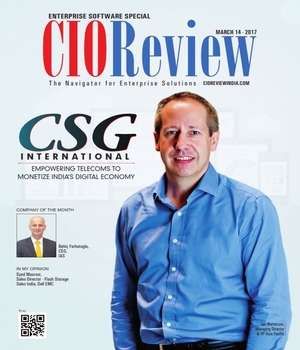
How enterprises can build complex software applications using high-performance low code platforms
Subrato Bandhu, Regional VP, OutSystems India | Thursday, 22 September 2022, 13:37 IST
 India’s internet penetration rate was reported to have increased by 5.4%, or 34 million people between 2021 - 2022, with a Deloitte study predicting that the nation will have more than 1 billion smartphone users by 2026 thanks to rural areas driving the sale of internet-enabled phones. The massive adoption of smartphones over the past few years has encouraged businesses to move toward digital transformation, with most Indian companies working towards developing mobile-friendly applications to interact with their end customers.
India’s internet penetration rate was reported to have increased by 5.4%, or 34 million people between 2021 - 2022, with a Deloitte study predicting that the nation will have more than 1 billion smartphone users by 2026 thanks to rural areas driving the sale of internet-enabled phones. The massive adoption of smartphones over the past few years has encouraged businesses to move toward digital transformation, with most Indian companies working towards developing mobile-friendly applications to interact with their end customers.
With almost every business adopting a digital strategy and the government encouraging the use of digital platforms, it has become imperative for Indian firms to deliver exceptional experiences through online and mobile platforms. Businesses without a digital strategy that prioritizes developing custom-built software risk losing customers and falling behind.
With the pandemic accelerating the pace of digital initiatives, many enterprises have sought to address their business-related requirements by buying off-the-shelf software. However, as the experiences of many Indian enterprises show, the use of off-the-shelf software comes with its own set of challenges. While such products give organizations the capability to quickly run applications, it comes at the cost of limited customization. Off-the-shelf software tends to offer the same solution to all customers in a world – a clear misfit for today’s customers that demand unique and personalized experiences. Major software vendors that churn out products at a massive scale cannot offer products and services that allow for that level of customization since it would not be profitable or feasible for them to do so.
The inadequacies of Off-the-Shelf Software
In a highly digitally competitive world, the pressure to launch new digital apps quickly leads many businesses to buy layer upon layer of off-the-shelf SaaS products designed for a mass audience that isn’t customized to the needs of any specific audience. This prevents companies from optimizing for and adapting to changing customer needs and new business opportunities while creating a host of new problems.
Some of these problems include:
-
Buying off-the-shelf software that limits customization, leading to a lost competitive advantage, as peer companies would be buying the same solution.
-
Most enterprises end up buying multiple off-the-shelf software solutions from different vendors. This can become a complex nightmare, with entangled architectures, code, and processes that increase maintenance and management time and reduce productivity. The more time spent in maintaining an architecture translates into less time developing outstanding customer and employee experiences
-
Integrating multiple systems takes a huge amount of time and efforts.
-
Buying off-the-shelf software also translates into increased dependency on the software solutions vendor. Any end-of-life solution can burden the customer, who has to rethink its IT strategy down the line and often undergo complex and expensive migration projects
Over a period of time, we have observed that these problems worsen and undermine innovation by consuming scarce resources. This can lead to burnout in IT departments. These vulnerabilities won’t go away on their own; in fact, they will continue to rise to the surface at a time when speed and differentiation are critical to survival. By contrast, when businesses use custom-built software for the long term, their IT teams can make changes as needed to respond to evolving customer needs and market opportunities, offering a massive competitive advantage.
Leveraging high-performance low-code platforms to quickly build custom software
Enterprises have always faced the dilemma of choosing between buying off-the-shelf software and building their own application or software. When enterprises buy, there is lack of customization and when enterprises build, it comes at a higher cost and effort. A low -code platform offers the perfect balance by helping enterprises develop apps quickly.
A case in point is Edelweiss, one of India’s leading financial services companies. In the past, the company’s manual and decentralized processes made it difficult to respond quickly and efficiently to client needs. The company decided to try a new approach by using a low-code platform for developing its digital lending platform. In just six months, Edelweiss launched a platform that has helped it cut processing costs by two-thirds. Today, Edelweiss’s digital lending platform automates much of the loan origination process, dramatically accelerating lending decisions. The platform has eliminated paper-based forms from the customer onboarding journey and instantly and dynamically validates each applicant’s creditworthiness as the user progresses through the application process. Impressed with the agility gained, Edelweiss has shifted all ongoing and future development to the low code platform.
There are hundreds of such cases, where high-performance low-code platforms have made a huge difference. Insurance company AXA built a self-service broker portal in just three months, while Telkomsel, Indonesia’s largest wireless carrier with over 169 million customers, cut development time from two years to four months.
By ditching solutions that limit differentiation, all the above-mentioned firms and countless others have kicked off a new approach to build for the future they want, not a future imposed on them. Many business leaders incorrectly think it’s too expensive or too complicated to do something similar, so they overlook the power of modern approaches to application development. But only businesses that take ownership of their software innovation will survive and thrive in this quickly evolving world.
CIO Viewpoint
Low-code Gaining Integrated Enterprise-wide...
By Suresh Jagannathan, COO, Digital Process Automation, Coforge
Future-proof Your Organization with Low Code
By Utsav Turray, Head of Product Marketing – Newgen Software
Realities of 'Cyberistic' Future
By Mohit Bhishikar, CIO and Mohit Gugale, Cyber Security Expert, Persistent Systems
CXO Insights
How enterprises can build complex software...
By Subrato Bandhu, Regional VP, OutSystems India
Facilitation Of Hyperautomation In The Digital...
By Arvind Jha, General Manager - Product Management And Marketing, Newgen Software
Devops / Devsecops Predictions For 2022






.jpg)





